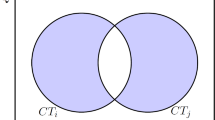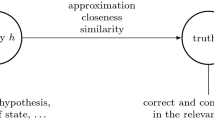Abstract
Truthlikeness is a property of a theory or a proposition that represents its closeness to the truth. We start by summarizing Niiniluoto’s (Truthlikeness, Reidel, Dordrecht, 1987) proposal of truthlikeness for deterministic laws (DL), which defines truthlikeness as a function of accuracy, and García-Lapeña’s (Br J Philos Sci, Forthcoming, 2021) expanded version, which defines truthlikeness for DL as a function of two factors, accuracy and nomicity. Then, we move to develop an appropriate definition of truthlikeness for probabilistic laws (PL) based on Niiniluoto’s (Truthlikeness, Reidel, Dordrecht, 1987) suggestion to use the Kullback–Leibler divergence to define the distance between a probability law \(X\) and the true probability law \(T\). We argue that the Kullback–Leibler divergence seems to be the best of the available probability distances to measure accuracy between PL. However, as in the case of DL, we argue that accuracy represents a necessary but not sufficient condition, as two PL may be equally accurate and still one may imply more true or truthlike consequences, behaviours or true facts about the system than the other. The final proposal defines truthlikeness for PL as a function of two factors, p-accuracy and p-nomicity, in intimate connexion with García-Lapeña’s proposal for DL.








Similar content being viewed by others
Notes
In Oddie’s proposal, the elements \(c_{1} , c_{2} ,c_{3} \ldots\) represent possible worlds. Niiniluoto’s framework is more flexible, allowing to represent state descriptions, structure descriptions, monadic constituents or scientific laws, depending on our cognitive interests.
When the target \(c_{t}^{*}\) represents the true law \(T\), it may no longer be conceived as the actual world or the most informative true description of the world given \({ }L\). See Sect. 3.4.
Specifically, \(d^{min - sum} \left( {h,c_{t}^{*} } \right) = \gamma *d^{min} \left( {h,c_{t}^{*} } \right) + \gamma^{{\prime }} d^{sum} \left( {h,c_{t}^{*} } \right)\), where \(0 < \gamma \le 1\) and \(0 < \gamma^{{\prime }} \le 1\). Parameters \(\gamma\) and \(\gamma^{{\prime }}\) indicate the relative weights of both factors. See Niiniluoto (1987) for other measures that Niiniluoto considers.
See Oddie (2013) for an extensive discussion of the general principles characterizing the different approaches to truthlikeness and the different implications of “average” and “min-sum”; and Cevolani (2017) for a deep analysis of measure sensitive in truthlikeness measures. For Niiniluoto’s comparison between \(average\) and \(minsum\) see 1987, Chapter 6.6. and Kuipers (1987) Chapter 1.
See for instance Greiner et al., (1997).
Formally, a probability space is a 3-tuple \(\left\langle {{\Omega },{\mathcal{F}},P} \right\rangle\), where \({\mathcal{F}}\) is a collection of events (sets of simple or compound outcomes) and \(P\) is defined as a function \(P:{\mathcal{F}} \to \left[ {0,1} \right]\). In order to simplify the exposition, we take the limiting case where \({\mathcal{F}} = {\Omega }\).
We will use ‘\(f\left( x \right)\)’ to refer to either a (continuous) deterministic or probabilistic law. The context would make clear if we are representing a deterministic law or a probability density function.
Where \(d^{ma} \left( {A,B} \right)\) corresponds to the volume between the surfaces (the area in the two dimensional case) and \(d^{ch} \left( {A,B} \right)\) to the maximum distance between the surfaces. \(d^{eu} \left( {A,B} \right)\) can be bigger or smaller than \(d^{ma} \left( {A,B} \right)\) depending on the situation.
For counterexamples regarding the use of the Chebyshev metric to define truthlikeness, see García-Lapeña (2021).
The dashed line represents the slope of the true function.
Niiniluoto seems to agree with this claim, as he points outs that Liu’s case shows that truthlikeness regarding DL may be related to two different questions: “(i) what are the values of the true law? and (ii) what is the correct mathematical form of the true law?” (2018, p. 131), such that truthlikeness regarding DL should be considered as a “balanced combination of them” (ibid.).
The derivative in a point measures the “behaviour” of the function in the neighbourhoods of the point, describing how the variables are related near the point. Two functions with a very similar derivative across some interval will define a very similar behaviour between the variables across the interval, exhibiting a very similar “shape”. Therefore, by calculating the distance between the derivative functions one can numerically define how much two functions agree or disagree in shape (in nomicity). Again, one natural metric to define the distance between the derivative functions is the Minkowski metric. In that case, however, \(d^{eu} \left( {X^{{\prime }} ,T^{{\prime }} } \right)\) might be preferred to \(d^{ma} \left( {X^{{\prime }} ,T^{{\prime }} } \right)\) (see García-Lapeña, 2021, for further details).
I am deeply grateful to an anonymous referee for some great suggestions that have led to this formulation.
More precisely, the procedure is repeated thirty times and the final correlations are the resulting average.
Actual decay constants of real atoms are much lower. For instance, \(Cs^{137}\) has a \(\lambda\) around \(4.4*10^{ - 8}\). For the clarity of the example we choose bigger values, without loss of generality.
In order to avoid possible negative values of law \(B\) when \(x\) is large (due to its oscillations), suppose its oscillating shape is defined for the range \(- x_{m} , \ldots , 0, \ldots ,x_{n}\), such that a complete number of cycles are performed, and outside that range law \(B\) equals law \(A\).
KL is not used to measure the distance between derivative functions as entropy is not a defined property for derivatives of density functions. In fact, the “entropy” of the derivative of any normal distribution is zero.
References
Amari, S.-I. (2009). Divergence is unique, belonging to both-divergence and Bregman divergence classes. IEEE Transactions on Information Theory, 55(11), 4925–4931.
Barnett, D. (1944). Chemical Engineering Thermodycamics. New York: McCraw-Hill Book Company.
Cevolani, G. (2017). Truthlikeness and the problem of measure sensitivity. In: EPSA15 selected papers (pp. 257–271). Springer.
Cevolani, G., & Festa, R. (2020). A partial consequence account of truthlikeness. Synthese, 197, 1627–1646.
Cha, S.-H. (2007). Comprehensive survey on distance/similarity measures between probability density functions. International Journal of Mathematical Models and Methods in Applied Sciences, 1(4), 300–307.
Cha, S.-H., & Srihari, S. (2002). On measuring the distance between histograms. Pattern Recognition, 35, 1355–1370.
Cohen, L. (1980). What Has Science to Do with Truth? Synthese, 45(3), 489–510.
Cover, T. M., & Thomas, J. A. (2006). Elements of information theory. Wiley.
Csiszár, I. (1967). On topological properties of f-divergences. Studia Mathematicarum Hungarica, 2, 329–339.
Deza, M., & Deza, E. (2013). Encyclopedia of distances. Springer.
Feller, W. (1971). An introduction to probability theory and its applications (2nd ed.). . Hoboken: Wiley.
Festa, R. (1986). A measure for the distance between an interval hypothesis and the truth. Synthese, 67(2), 273–320.
García-Lapeña, A. (2021). Truthlikeness for quantitative deterministic laws. The British Journal for the Philosophy of Science. Forthcoming.
Gibbs, A., & Su, F. (2002). On choosing and bounding probability metrics. International Statistical Review, 70(3), 419–435.
Greiner, W., Neise, L., & Stöcker, H. (1997). Thermodynamics and statistical mechanics. Berlin: Springer.
Hilpinen, R., et al. (1976). Approximate truth and truthlikeness. In M. Przelecki (Ed.), Formal methods in the methodology of the empirical sciences (pp. 19–42). Dordrecht: Reidel.
Kieseppä, I. A. (1996). Truthlikeness for multidimensional, quantitative cognitive problems. Kluwer.
Koslow, A. (2003). Laws, explanations and the reduction of possibilities. In: H. Lillehammer, G. Rodriguez-Pereyra (eds.), Real metaphysics (pp. 169–183). Routledge.
Krane, K. (1988). Introductory to nuclear physics. Wiley.
Kuipers, T. (1982). Approaching Descriptive and Theoretical Truth. Erkenntnis, 18(3), 343–378.
Kuipers, (Ed.). (1987). What is closer-to-the-truth? Rodopi.
Kullback, S., & Leibler, R. A. (1951). On information and sufficiency. Annals of Mathematical Statistics, 22(1), 79–86.
Liu, C. (1999). Approximation, idealization, and laws of nature. Synthese, 118(2), 229–256.
Maudlin, T. (2007). The metaphysics within physics. Oxford University Press.
Niiniluoto, I. (1982). Truthlikeness for quantitative statements. PSA: Proceedings of the Biennial Meeting of the Philosophy of Science Association, 182, 208–216.
Niiniluoto, I. (1983). Verisimilitude vs. Legisimilitude. Studia Logica, 42, 315–329.
Niiniluoto, I. (1987). Truthlikeness. Reidel.
Niiniluoto, I. (1990). Theories, approximations, and idealizations. Poznan Studies in the Philosophy of the Sciences and the Humanities, 16, 9–57.
Niiniluoto, I. (1994). Truthlikeness misapplied: A reply to Ernest W. Adams. Synthese, 101(2), 291–300.
Niiniluoto, I. (1998). Verisimilitude: The third period. The British Journal for the Philosophy of Science, 49(1), 1–29.
Niiniluoto, I. (2018). Truth-seeking by abduction. Springer.
Niiniluoto, I. (2020). Truthlikeness: Old and new debates. Synthese, 197, 1581–1599.
Oddie, G. (1982). Cohen on Verisimilitude and Natural Necessity. Synthese, 51(3), 355–379.
Oddie, G. (1986). Likeness to truth. Reidel.
Oddie, G. (2013). The content, consequence and likeness approaches to verisimilitude: Compatibility, trivialization, and underdetermination. Synthese, 190(9), 1647–1687.
Oddie, G. (2016). Truthlikeness. In: E. N. Zalta (Ed.), The stanford encyclopedia of philosophy (Winter 2016 Edition).
Oddie, G. (2019). What accuracy could not be. British Journal for the Philosophy of Science., 70(2), 551–580.
Rosenkrantz, R. D. (1980). Measuring truthlikeness. Synthese, 45(3), 463–487.
Shannon, C. E. (1948). A mathematical theory of communication. Bell System Technical Journal, 27(3), 379–423.
Thom, R. (1975). Structural stability and morphogenesis: An outline of a general theory of models. Addison-Wesley.
Tichý, P. (1974). On popper’s definitions of verisimilitude. British Journal for the Philosophy of Science, 25(2), 155–188.
Tuomela, R. (1978). Verisimilitude and theory-distance. Synthese, 38, 215–246.
Weller-Fahy, D. J., Borghetti, B. J., & Sodemann, A. A. (2015). A survey of distance and similarity measures used within network intrusion anomaly detection. IEEE Communications Surveys & Tutorials, 17(1), 70–91.
Weston, T. (1992). Approximate truth and scientific realism. Philosophy of Science, 59(1), 53–74.
Zwart, S. D., & Franssen, M. (2007). An impossibility theorem for verisimilitude. Synthese, 158(1), 75–92.
Acknowledgements
I am deeply thankful to the two anonymous referees for all for their helpful comments and suggestions on previous versions of this paper; to Ilkka Niiniluoto, for the many rich conversations discussing the issues developed here; to Carlos García, for his key ideas regarding the mathematical formulation offered; to Javier Suárez, for the many excellent suggestions on previous versions of the paper; and to the members of LOGOS (Research Group in Analytic Philosophy, Barcelona) for their unvalued feedback and support. Research for this work has been supported by Generality of Catalonia (FIb200016).
Author information
Authors and Affiliations
Corresponding author
Additional information
Publisher's Note
Springer Nature remains neutral with regard to jurisdictional claims in published maps and institutional affiliations.
This article belongs to the topical collection “Approaching Probabilistic Truths”, edited by Theo Kuipers, Ilkka Niiniluoto, and Gustavo Cevolani.
Rights and permissions
About this article
Cite this article
García-Lapeña, A. Truthlikeness for probabilistic laws. Synthese 199, 9359–9389 (2021). https://doi.org/10.1007/s11229-021-03206-4
Received:
Accepted:
Published:
Issue Date:
DOI: https://doi.org/10.1007/s11229-021-03206-4




